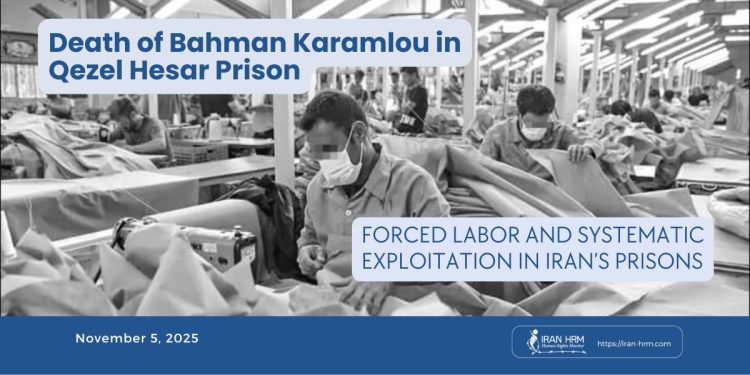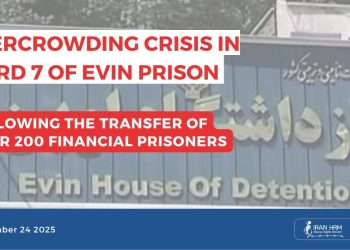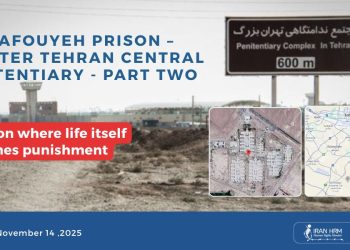A Death that Broke the Silence
Bahman Karamlou, a 50-year-old inmate in Qezel Hesar Prison near Karaj, died after enduring years of forced labor under harsh conditions. He had concealed his illness out of fear of being removed from the labor ward and losing minimal access to basic amenities. In Iran’s prison system, expulsion from the labor unit means losing privileges such as slightly better food or limited phone access. His silent death symbolizes how the ruling regime in Iran treats prisoners’ lives as expendable.
The Labor Ward in Qezel Hesar: From Rehabilitation to Coercion
Qezel Hesar Prison is one of the largest and most crowded prisons in Iran, housing tens of thousands of inmates. Thousands are forced to work daily in industrial workshops run under the control of the regime’s security apparatus, particularly the IRGC, through the Prisoners’ Cooperative Foundation. Officially presented as ‘rehabilitation,’ the labor ward functions as a de facto forced labor camp. Prisoners are compelled to work from early morning until evening, often after being given methadone—a process known as ‘fueling’—to keep them docile and compliant. Daily headcounts, degrading supervision, and neglect of medical needs illustrate the dehumanizing nature of this system. As one prisoner described: ‘Every morning they count us like livestock. We hand over our cards to be allowed to leave the ward. We are not names anymore—only numbers and barcodes.’
The Prison Economy: Exploitation and Paltry Wages
Over recent years, Qezel Hesar has become a production hub for the Prisoners’ Cooperative Foundation, manufacturing bicycles, tents, textiles, carpets, and auto parts. Prisoners receive between 500,000 and 2 million tomans per month—barely one-tenth of Iran’s legal minimum wage. Most of the profits are pocketed by prison officials and the Foundation, while prisoners are denied insurance and safety protections. Inmates are often coerced into these jobs with promises of reduced sentences or ‘welfare points,’ which rarely materialize.
Dependency and Humiliation
Drug dependency is deliberately cultivated in the labor ward. Prison authorities distribute methadone and sedatives to keep inmates subdued. According to credible sources, over 90% of prisoners in the labor unit are addicted to controlled substances. This dependency, combined with economic coercion and daily humiliation, leaves no space for protest or resistance. Bahman Karamlou was one of those silenced victims—worked to exhaustion, denied care, and forgotten.
Violations of International Law
Forced labor in Iranian prisons violates multiple provisions of international human rights instruments: Article 3 (Right to Life, Liberty, and Security), Article 4 (Prohibition of Slavery and Forced Labor), Article 5 (Prohibition of Torture and Cruel, Inhuman or Degrading Treatment), Article 23 (Right to Just and Favorable Conditions of Work), and Article 25 (Right to an Adequate Standard of Living) of the Universal Declaration of Human Rights. The Nelson Mandela Rules explicitly require that prison labor must be voluntary, safe, and aimed at rehabilitation—standards blatantly ignored by the ruling regime in Iran.
Prisons as Profit Centers
Iran’s prisons have transformed from correctional institutions into profit-generating enterprises. The Prisoners’ Cooperative Foundation operates more than 700 facilities nationwide, employing roughly 100,000 inmates. Yet prisoners see little of this profit, as revenue flows to government-linked institutions and officials. This structure perpetuates a shadow economy built on forced labor and exploitation of captive workers.
Human and Social Dimensions
The forced labor system devastates not only inmates but also their families, who depend on the meager income from prison work. Many prisoners, particularly those jailed for financial offenses, are victims of poverty rather than crime. Inside prison, that same poverty is exploited—transformed into physical and psychological enslavement. Bahman Karamlou’s death lays bare the human cost of this exploitation.
International Reactions and Call to Action
International human rights organizations, including Amnesty International, the UN High Commissioner for Human Rights, and UN Special Rapporteurs on Iran, have repeatedly condemned Iran’s treatment of prisoners and the use of forced labor in its detention system. Recent reports describe these practices as modern-day slavery and a violation of the Nelson Mandela Rules. The global community must press for independent inspections of Iran’s prisons and hold officials accountable. As long as this system persists, every product leaving Iran’s prison workshops carries the suffering and silence of those enslaved within.
Continuation of the Series
The death of Bahman Karamlou in Qezel Hesar Prison is only one exposed case of forced labor in Iran’s prisons. In subsequent reports of this series, we will document the exploitation of inmates in other prisons—including those in Isfahan, Urmia, Sheiban (Ahvaz), and Qarchak Varamin—to reveal the full scope of this nationwide system of coercion and abuse.







